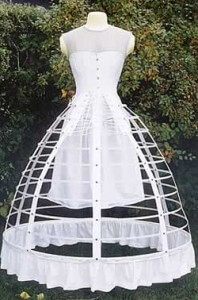Up until the 18th century ‘decent’ women had always gone “knickerless”. Empire fashions at the turn of the 19th century were little more than sheer nightgowns so for modesty’s sake it was important for women to wear some kind of undergarment. Simple stretch pantaloons were created made of skin-toned stockinette, coming to just below the knee.
With the fashion for draughty, hooped cage crinolines women had to adopt the warmer “drawers” or “knickerbockers” similar to the men’s- laced at the back waist, legs gathered in below the knee and an open crotch from front to back. The term “pair of” knickers or panties’ comes from the two separate legs being only attached at the waist. The Victorians loved this feature, it was hygienic and convenient since they didn’t require frequent underwear changes. By the end of the 19th century Knickerbockers, (where the term ‘Knickers’ comes from) were part of everyday wear and only the poorest went without. Gradually they were modified into shorter ‘Bloomers’ or fine cotton ‘closed drawers’ with a side waist opening. Parisian Cancan dancers famously chopped their ‘bloomers’ short to reveal more thigh!
With the modern flapper fashions, old underwear styles were cast aside for the newer, slimmer lines. By the 1920’s women were wearing body skimming “Directoire” knickers with elasticated legs and waist – more practical to wear with the shorter skirt lengths in fashion. Skirt-knicker versions became known as “French Knickers” which were often open legged. Female undergarments contracted even further with the slinkier bias cut garments of the 30’s, thinner, lighter materials were preferred and an affordable artificial silk was invented made from rayon called “Art Silk”.
During the Second World War, “Directoire” knickers worn by women in the Armed Forces were nick-named “Passion Killers” because of their unshapely appearance and dull colors. By the 1950’s nylons and elastics had revolutionized undies. Knickers were mass produced and the designs were simplified. “Bikini Briefs” became popular in the 60’s for wearing under the new short mini skirts and super tight trousers. As the fashion for lower waists grew so did the panty waists and “Hip Huggers” became popular, even lower and they were called “Bikini Panties”. By the 70’s cotton gussets were finally introduced to nylon briefs for comfort and hygiene and new stretchy gloss and lace fabrics became fashionable.
The 80’s established the “Designer Knicker” epitomized by Calvin Klein’s underwear range with it’s unisex styling and bold logo elastics. Legs were cut high to elongate the leg, a thick elastic waistband finished at the navel and the butt cheeks got increasingly less coverage. As the brief got even smaller it became a “Tanga”.
Meanwhile Brazil was experimenting with more erotic undies like G-Strings and Thongs, beloved of exotic dancers and the fashion for this minimal coverage soon spread to Europe and North America. While maintaining their popularity for nearly two decades, the fashion for the thong has gradually waned. These days companies are designing fresh trends for ultra-popular Boyshorts, High-cut Briefs and Shapewear in a myriad of comfy and seamless fabrics, in line with more modern fashions.
Ask me about fashion and lingerie! Your question could be the topic of my next blog,
Teresa
teresa@nowthatslingerie.com
Vintage lingerie images from: Fashion-Era http://www.fashion-era.com/drawers-pants-combinations-knickers-fashion.htm
Empire illustration from: empire fashions pictures – Google Search
Glossies image from Advertising Archives: The Advertising Archives picture library – Largest collection of vintage & modern adverts, magazine illustrations, cover art & posters: UK & USACatalogue/ Brochure Plate | fashion
Hooped cage crinoline image: Sous l’Empire des crinolines : Anna Galore Le blog






Leave a Comment